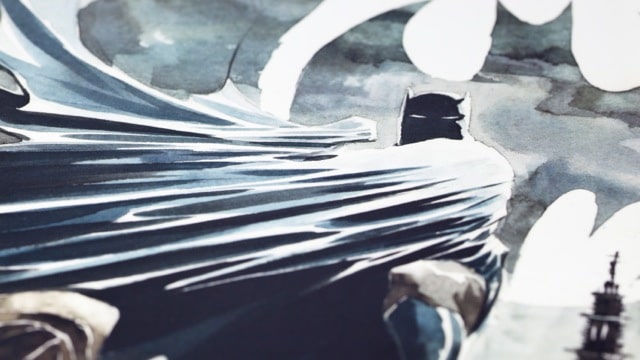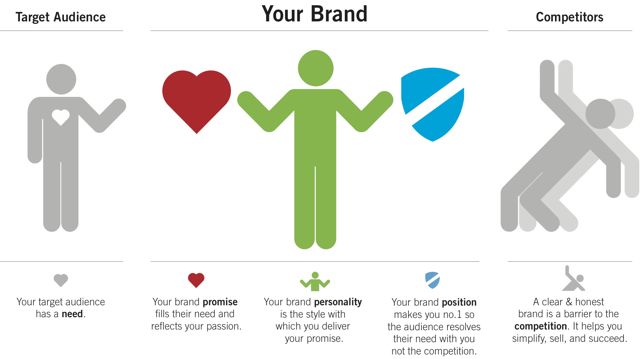In 1939 the Batman made his first appearance in Detective Comics #27. Six issues later he got his origin story when Americans were introduced to the young Bruce Wayne who witnesses his parents murdered in cold blood. Bruce swears to avenge their deaths and as the years pass, he steels himself for the task. Finally, one creepy night he says to himself “I am ready. But first I need a disguise.” At that moment a huge bat enters Wayne mansion. “A Bat! That’s it! It’s an omen… I shall become a Bat!”
In the decades since, the Batman has grown into a global brand because he embodies an incredible story — one that translates into a compelling brand strategy. Like any quality brand strategy model, this one has an audience, competition, a promise, position and personality.
The Batman Audience
Within the story, criminals are Bruce Wayne’s primary target audience, not the victims of crime, nor the general population of his hometown Gotham City. Contrast this with Superman, whose audience and appearance are both tuned to amaze and inspire the public. Plus, Bruce Wayne does his audience research. In early origin stories, he studies criminology. In the recent Christopher Nolan film Batman Begins, he even briefly becomes a criminal to learn their mindset.
The Batman Competition
The definition of competition is inextricably linked to the definition of audience. To the criminal, Batman is competing for their capture against other crime fighters, be they corrupt Gotham cops, the upright Inspector Gordon, other heroes or vigilantes. He is also competing against other heroes in the comic stores and theaters. In some ways, the Batman brand is similar to a not-for-profit that seeks to differentiate from others, not always labeling them as competition, and sometimes cooperating with them.
The Batman Brand Promise
In the original Batman origin story, the young Bruce Wayne kneels in prayer by his bed and says “I swear by the spirits of my parents to avenge their deaths by spending the rest of my life warring on criminals.” A promise is a contract you make with your audience, and the Batman promises vengeance.
Brand Position
The brand position is what makes you different then your competition. In this case, our hero was the only crime fighter to take on the persona of a bat. Batman also blew open a new genre, that of the vigilante super hero without super powers. This may also account for his market success. He was created by DC after Superman, a hero that represented light, justice and invincibility. Batman was positioned on the other side of the spectrum, still a hero but dark, vengeful and vulnerable.
Brand Personality
Consider the brand personalities of other DC heroes like Superman or Wonder Woman. Their personalities are directed to the citizens they protect. Batman’s personality is attuned to the criminals he is warring against. The original comic ends with a panel showing the first appearance of the Batman with the words “And thus is born this weird figure of the dark… This avenger of evil. The Batman.” When in costume, prowling the streets of Gotham, the Batman truly embodies a brand personality that is both weird and fearsome.
Batman and Brand Strategy: The Lessons
- Audience – Batman is not trying to be all things to all people. He has built his brand around a carefully defined target audience. You should be doing the same.
- Competition – It would be easy to assume that Batman’s competition is criminals; they are after all trying to defeat him. But in reality a savvy brand understands that it is the perspective of the audience that defines the competition. Make no assumptions. Ask your competition who they perceived as being the alternative to your solution.
- Promise – The Batman promise of vengeance is so powerful because it is so focused and has a potent story behind it. Decade after decade, story after story, vengeance is what Batman is delivering to his audience. Be clear on your brand promise, make it known and deliver on it relentlessly.
- Positioning – Most brands are afraid to truly differentiate. Standing out from the crowd goes against human nature, but in business you differentiate or die. How can you stand out from your competition in a way that makes your audience want you more than anyone else?
- Personality – Here at Distility, we like the weird and fearsome Batman personality. In the 1950s and 1960s, due to changes made by the Comics Code Authority, Batman was forced to become light and campy and the comic book side of the franchise suffered. Be sure to find a winning brand personality and stick with that style. Don’t let a weak personality dilute your brand strategy.
- When brand strategy components converge – Some brands are so tightly defined that they have overlap or leakage between the concepts explored above. In the case of Batman, terrifying criminals, crime fighters, vengeance, being bat-like, being weird and being frightening are pretty similar territory. It works for Batman. But a firm that promises innovation, says it has the most innovative solutions, and has an innovative personality is very likely just wasting brand strategy space. Whatever its composition, the key is to make sure your brand strategy has synergy.


